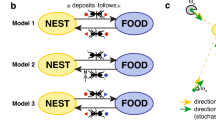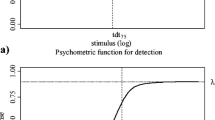Abstract
Communication improves decision-making for group-living animals, especially during foraging, facilitating exploitation of resources. Here we model the trail-based foraging strategy of Pharaoh’s ants to understand the limits and constraints of a specific group foraging strategy. To minimise assumptions we used model parameters acquired through behavioural study. Pharaoh’s ants (Monomorium pharaonis) exploit the geometry of trail networks bifurcations to make U-turns, if they are walking the wrong way. However, 7% of foragers perform apparently incorrect U-turns. These seemingly maladaptive U-turns are performed by a consistent minority of specialist U-turners that make frequent U-turns on trails and lay trail pheromones much more frequently compared to the rest of the colony. Our study shows a key role for U-turning ants in maintaining the connectivity of pheromone trails. We produced an agent-based model of a heterogeneous ant community where 7% of agents were specialised frequent U-turners whilst the remaining 93% rarely U-turned. Simulations showed that heterogeneous colonies enjoyed significantly greater success at foraging for distant food resources compared to behaviourally homogeneous colonies. The presence of a cohort of specialised trail-layers maintains a well-connected network of trails which ensures that food discoveries are rapidly linked back to the nest. This decentralised information transfer might ensure that foragers can respond to dynamic changes in food distribution, thereby allowing more individuals in a group to benefit by successfully locating food finds.
Similar content being viewed by others
References
Acosta FJ, Lopez F, Serrano JM (1993) Branching angles of ant trunk trails as an optimization cue. J Theor Biol 160: 297–310
Beckers R, Deneubourg JL, Goss S (1992) Trails and U-turns in the selection of a path by the ant Lasius niger. J Theor Biol 159: 397–415
Beekman M, Sumpter DJT, Ratnieks FLW (2001) Phase transition between disordered and ordered foraging in Pharaoh’s ants. Proc Natl Acad Sci USA 98: 9703–9706
Camazine S, Deneubourg J, Franks NR, Sneyd J, Theraulaz G, Bonabeau E (2001) Self-organization in biological systems. Princeton University Press, Princeton
Dall SRX, Giraldeau L, Olsson O, McNamara JM, Stephens DW (2005) Information and its use by animals in evolutionary ecology. Trends Ecol Evol 20: 187–193
Danchin E, Giraldeau L, Valone TJ, Wagner RH (2004) Public information: from nosy neighbours to cultural evolution. Science 304: 487–491
DeAngelis DL, Rose KA, Huston MA (1994) Individual-oriented approaches to modelling ecological populations and communities. In: Levin SA (eds) Front Math Biol. Springer, Berlin, pp 390–410
Dechaume-Moncharmont F, Dornhaus A, Houston AI, McNamara JM, Collins EJ, Franks NR (2005) The hidden costs of information in collective foraging. Proc Roy Soc B 272: 1689–1695
Dorigo M, Di Caro G, Gambardella LM (1999) Ant algorithms for discrete optimisation. Artif Life 5: 137–172
Edelstein-Keshet L, Watmough J, Ermentrout GB (1995) Trail following in ants: individual properties determine population behaviour. Behav Ecol Sociobiol 36: 119–133
Ermentrout GB, Edelstein-Keshet L (1993) Cellular automata approaches to biological modelling. J Theor Biol 160: 97–133
Fahse L, Wissel C, Grimm V (1998) Reconciling classical and individual-based approaches in theoretical population ecology. Am Nat 152: 838–852
Fourcassié V, Deneubourg JL (1994) The dynamics of collective exploration and trail-formation in Monomorium pharaonis: experiments and model. Physiol Entomol 19: 291–300
Grimm V (1999) Ten years of individual-based modelling in ecology: what have we learned and what could we learn in the future?. Ecol Model 115: 129–148
Hart AG, Jackson DE (2006) U-turns on ant trails. Curr Biol 16: R42–43
Holcombe M (1988) X-machines as a basis for dynamic system specification. Software Eng J 3: 69–76
Hölldobler B, Wilson E0 (1990) The Ants. The Belknap Press of Harvard University, Cambridge
Jackson DE, Ratnieks FLW (2006) Communication in ants. Curr Biol 16: 570–574
Jackson DE, Holcombe M, Ratnieks FLW (2004) Trail geometry gives polarity to ant foraging networks. Nature 432: 907–909
Jackson DE, Martin S, Holcombe M, Ratnieks FLW (2006) Longevity and detection of persistent foraging trails in Pharaoh’s ants, Monomorium pharaonis. Anim Behav 71: 351–359
Kaiser H (1979) The dynamics of populations as a result of the properties of individual animals. Forts Zool 25: 109–136
Krause J, Ruxton GD (2002) Living in groups. Oxford University Press, Oxford
Krebs JR, Davies NB (1997) Behavioural ecology, 4th edn. Blackwell, Oxford
Lugo AE, Farnworth EG, Pool D, Jerez P, Kaufman G (1973) The impact of the leaf cutter Atta colombica on the energy flow of a tropical wet forest. Ecology 54: 1292–1301
Meuth R, Lim MH, Ong YS, Wunsch DC (2009) A proposition on memes and meta-memes in computing for higher-order learning. Memetic Comput J 1: 85–100
Peacock AD, Sudd JH, Baxter AT (1955) Studies in Pharaoh’s ant, Monomorium pharaonis II. Dissemination. Entomol Mag 91: 130–133
Schweitzer F, Lao K, Family F (1997) Active Random walkers simulate trunk trail formation by ants. Biosystems 41: 153–166
Sudd JH (1960) The foraging method of Pharaoh’s ant, Monomorium pharaonis. Anim Behav 8: 67–75
Solé RV, Bonabeau E, Delgado J, Fernandez P, Marin J (2001) Pattern formation and optimization in army ant raids. Artif Life 6: 219–226
Vincent AD, Myerscough MR (2004) The effect of a non-uniform turning kernel on ant trail morphology. J Math Biol 49: 391–432
Ward P, Zahavi A (1973) The importance of certain assemblages of birds as “information centres” for food finding. Ibis 119: 517–534
Wilson EO (1962) Chemical communication among workers of the fire ant, Solenopsis saevissima. I. The organisation of mass foraging. Anim Behav 10: 134–164
Wilson EO (1971) The insect societies. Belknap Press of Harvard, Cambridge
Author information
Authors and Affiliations
Corresponding author
Rights and permissions
About this article
Cite this article
Jackson, D.E., Bicak, M. & Holcombe, M. Decentralized communication, trail connectivity and emergent benefits of ant pheromone trail networks. Memetic Comp. 3, 25–32 (2011). https://doi.org/10.1007/s12293-010-0039-2
Received:
Accepted:
Published:
Issue Date:
DOI: https://doi.org/10.1007/s12293-010-0039-2




